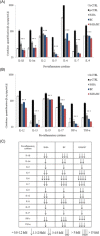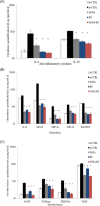Unsulfated biotechnological chondroitin by itself as well as in combination with high molecular weight hyaluronan improves the inflammation profile in osteoarthritis in vitro model
- PMID: 34056757
- PMCID: PMC8453819
- DOI: 10.1002/jcb.29907
Unsulfated biotechnological chondroitin by itself as well as in combination with high molecular weight hyaluronan improves the inflammation profile in osteoarthritis in vitro model
Abstract
Several studies suggest that inflammation has a pivotal role during the progression of osteoarthritis (OA) and cytokines have been identified as the main process mediators. This study aimed to explore the ability to modulate the main OA pro-inflammatory biomarkers of novel gels (H-HA/BC) based on high molecular weight hyaluronan (H-HA) and unsulfated biotechnological chondroitin (BC). For the first time, BC was tested also in combination with H-HA on human primary cells isolated from pathological knee joints. Specifically, the experiments were performed using an OA in vitro model based on human chondrocytes and synoviocytes. To evaluate the anti-inflammatory effects of H-HA/BC in comparison with H-HA and BC single gels, NF-kB, COMP-2, MyD88, MMP-13 and a wide range of cytokines, known to be specific biomarkers in OA (e.g., IL-6, IL-8, and TNF-α), were evaluated. In addition, cell morphology and proliferation occurring in the presence of either H-HA/BC or single components were assessed using time-lapse video microscopy. It was shown that synovial fluids and cells isolated from OA suffering patients, presented a cytokine pattern respondent to an ongoing inflammation status. H-HA and BC significantly reduced the levels of 23 biomarkers associated with cartilage damage. However, H-HA/BC decreased significantly 24 biological mediators and downregulated 19 of them more efficiently than the single components. In synoviocytes cultures, cytokine analyses proved that H-HA/BC gels re-established an extracellular environment more similar to a healthy condition reducing considerably the concentration of 11 analytes. Instead, H-HA and BC significantly modulated 7 (5 only with a longer treatment) and 8 biological cytokines, respectively. Our results suggest that H-HA/BC beyond the viscosupplementation effect typical for HA-based gels, can improve the inflammation status in joints and thus could be introduced as a valid protective and anti-inflammatory intraarticular device in the field of Class III medical devices for OA treatments.
Keywords: biotechnological chondroitin; human articular chondrocytes; human synoviocytes; hybrid cooperative complexes; inflammation; osteoarthritis.
© 2021 The Authors. Journal of Cellular Biochemistry published by Wiley Periodicals LLC.
Conflict of interest statement
The authors declare that there are no conflict of interests.
Figures









Similar articles
-
Molecular Fingerprint of Human Pathological Synoviocytes in Response to Extractive Sulfated and Biofermentative Unsulfated Chondroitins.Int J Mol Sci. 2022 Dec 14;23(24):15865. doi: 10.3390/ijms232415865. Int J Mol Sci. 2022. PMID: 36555507 Free PMC article.
-
Novel Hybrid Gels Made of High and Low Molecular Weight Hyaluronic Acid Induce Proliferation and Reduce Inflammation in an Osteoarthritis In Vitro Model Based on Human Synoviocytes and Chondrocytes.Biomed Res Int. 2019 Apr 23;2019:4328219. doi: 10.1155/2019/4328219. eCollection 2019. Biomed Res Int. 2019. Retraction in: Biomed Res Int. 2022 Feb 22;2022:9873639. doi: 10.1155/2022/9873639. PMID: 31179322 Free PMC article. Retracted.
-
Hyaluronic Acid-Based Injective Medical Devices: In Vitro Characterization of Novel Formulations Containing Biofermentative Unsulfated Chondroitin or Extractive Sulfated One with Cyclodextrins.Pharmaceuticals (Basel). 2023 Oct 9;16(10):1429. doi: 10.3390/ph16101429. Pharmaceuticals (Basel). 2023. PMID: 37895900 Free PMC article.
-
Hyaluronan viscosupplementation: state of the art and insight into the novel cooperative hybrid complexes based on high and low molecular weight HA of potential interest in osteoarthritis treatment.Clin Cases Miner Bone Metab. 2016 Jan-Apr;13(1):36-7. doi: 10.11138/ccmbm/2016.13.1.036. Epub 2016 May 11. Clin Cases Miner Bone Metab. 2016. PMID: 27252742 Free PMC article. Review.
-
The role of cytokines in osteoarthritis pathophysiology.Biorheology. 2002;39(1-2):237-46. Biorheology. 2002. PMID: 12082286 Review.
Cited by
-
Molecular Fingerprint of Human Pathological Synoviocytes in Response to Extractive Sulfated and Biofermentative Unsulfated Chondroitins.Int J Mol Sci. 2022 Dec 14;23(24):15865. doi: 10.3390/ijms232415865. Int J Mol Sci. 2022. PMID: 36555507 Free PMC article.
-
Evaluation of novel biomaterials for cartilage regeneration based on gelatin methacryloyl interpenetrated with extractive chondroitin sulfate or unsulfated biotechnological chondroitin.J Biomed Mater Res A. 2022 Jun;110(6):1210-1223. doi: 10.1002/jbm.a.37364. Epub 2022 Jan 28. J Biomed Mater Res A. 2022. PMID: 35088923 Free PMC article.
-
Naturally Occurring Osteoarthritis Features and Treatments: Systematic Review on the Aged Guinea Pig Model.Int J Mol Sci. 2022 Jun 30;23(13):7309. doi: 10.3390/ijms23137309. Int J Mol Sci. 2022. PMID: 35806306 Free PMC article.
-
Impact of High-Molecular-Weight Hyaluronic Acid on Gene Expression in Rabbit Achilles Tenocytes In Vitro.Int J Mol Sci. 2022 Jul 18;23(14):7926. doi: 10.3390/ijms23147926. Int J Mol Sci. 2022. PMID: 35887273 Free PMC article.
-
Evaluation of unsulfated biotechnological chondroitin in a knee osteoarthritis mouse model as a potential novel functional ingredient in nutraceuticals and pharmaceuticals.Front Bioeng Biotechnol. 2022 Nov 17;10:934997. doi: 10.3389/fbioe.2022.934997. eCollection 2022. Front Bioeng Biotechnol. 2022. PMID: 36466352 Free PMC article.
References
-
- Hochberg MC, Altman RD, April KT, et al. American College of Rheumatology 2012 recommendations for the use of non pharmacologic and pharmacologic therapies in osteoarthritis of the hand, hip, and knee. Arthritis Care Res (Hoboken). 2012;4:465‐474. - PubMed
LinkOut - more resources
Full Text Sources
Other Literature Sources
Miscellaneous

